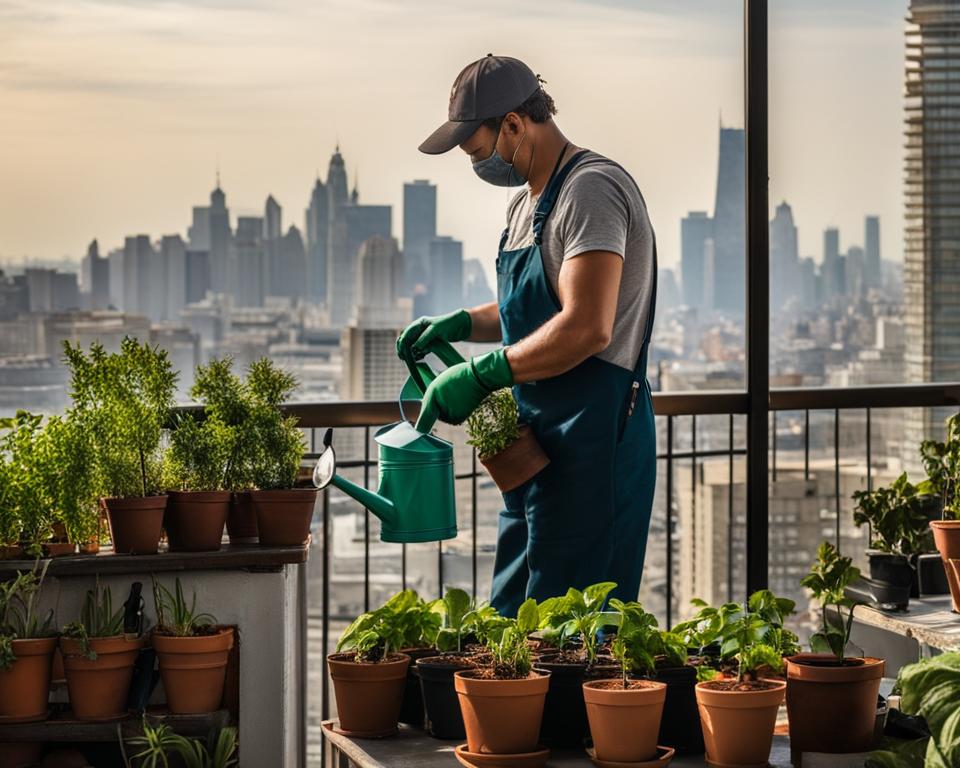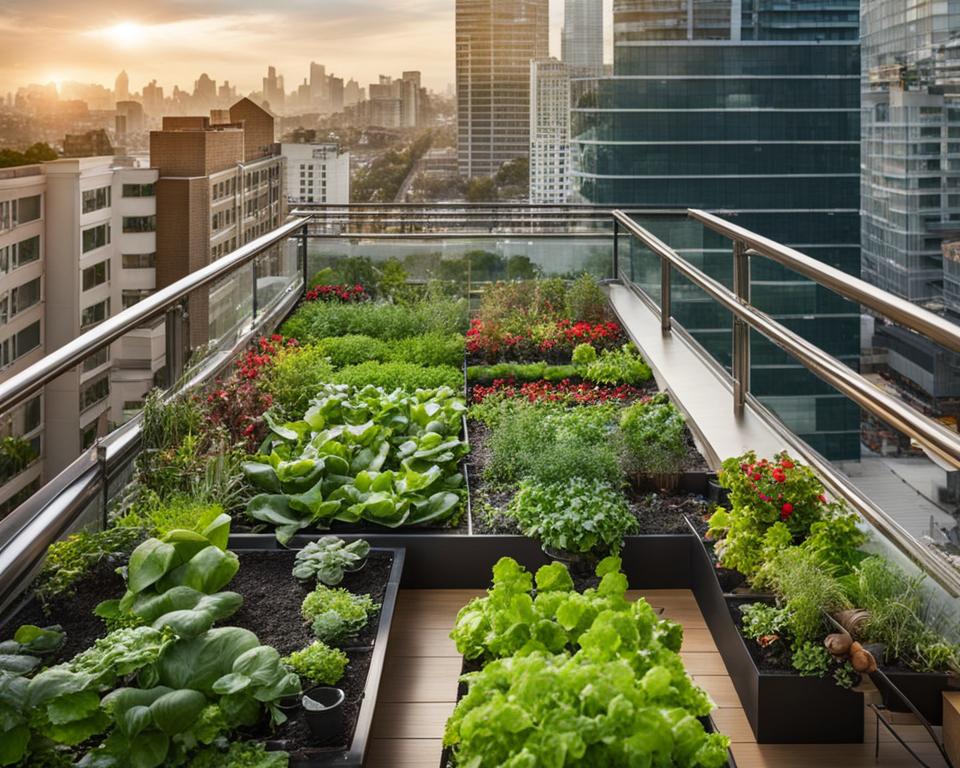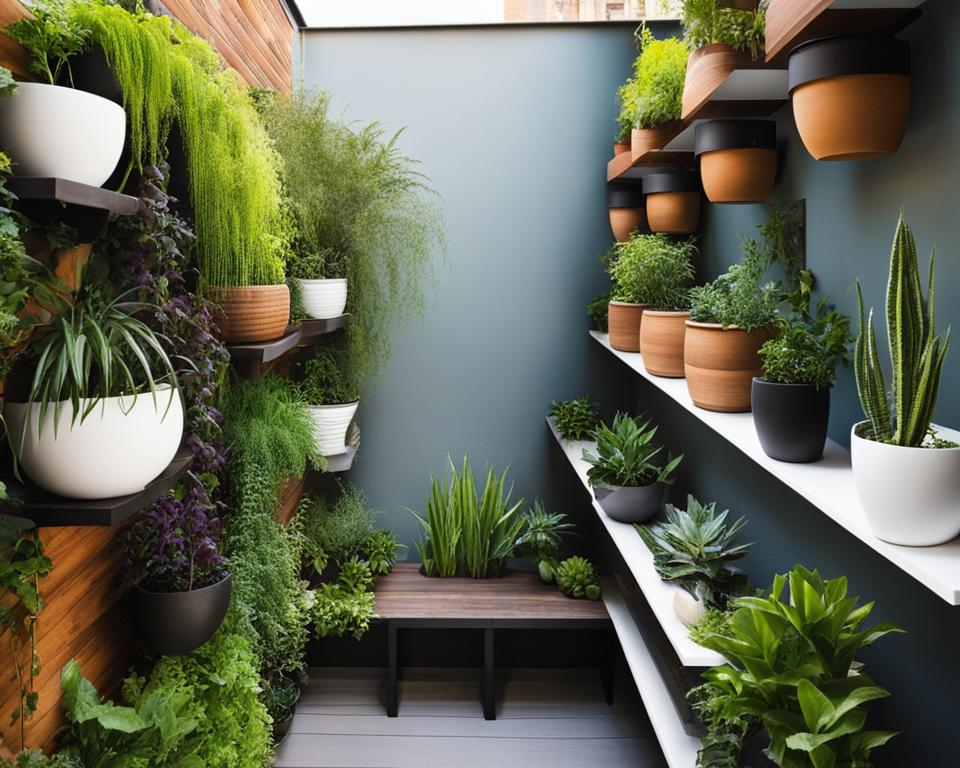Welcome to my guide on DIY urban gardening! If you have a small balcony and a desire for a green oasis, you’re in the right place. In this article, I will provide you with practical tips and tricks to transform your balcony into a thriving urban garden. Whether you’re a beginner or an experienced gardener, I’ve got you covered with expert advice and recommendations. Let’s dive in and create a beautiful space filled with nature’s beauty.
Essential Tools and Supplies
Having the right tools and supplies is essential for the success of your balcony garden. From quality soil and potting mixes to watering solutions and gardening tools, each element plays a crucial role in nurturing your plants. Let’s explore the essential tools and supplies you need to create a thriving urban oasis on your balcony.
Quality Soil and Potting Mixes
To provide your plants with a strong foundation, invest in quality soil and potting mixes. Look for options that are specifically formulated for container gardening, as they offer better drainage and nutrient retention. Consider factors like water retention, pH levels, and the specific needs of your plants when choosing the right soil and potting mix.
Watering Solutions
Ensuring proper watering is crucial for the health and growth of your plants. Depending on the size and layout of your balcony garden, you may opt for different watering solutions. Drip irrigation systems provide a consistent water supply directly to the plant roots, minimizing water wastage. Self-watering containers are another convenient option, as they have built-in reservoirs that slowly release water to the plants.
Fertilizers and Plant Nutrition
Plants require essential nutrients to thrive, and fertilizers play a key role in providing these nutrients. Organic fertilizers, such as compost or worm castings, are excellent choices for balcony gardens as they promote healthy growth without harmful chemicals. Additionally, consider slow-release fertilizers that gradually release nutrients over time, reducing the frequency of application and ensuring a steady supply of nutrients for your plants.
Gardening Tools
Basic gardening tools are essential for maintaining your balcony garden. Invest in a trowel for planting and transplanting, pruners for pruning and trimming, and gardening gloves to protect your hands. Depending on your specific needs, you may also consider tools like a hand rake, garden shears, or a watering can. Choose high-quality tools that are durable and comfortable to use, as they will make your gardening tasks much easier and enjoyable.
| Essential Tools and Supplies for Your Balcony Garden | |
|---|---|
| Quality Soil and Potting Mixes | Choose options specifically formulated for container gardening that offer good drainage and nutrient retention. |
| Watering Solutions | Consider drip irrigation systems or self-watering containers to provide consistent water supply and minimize water wastage. |
| Fertilizers and Plant Nutrition | Use organic fertilizers or slow-release options to provide essential nutrients for healthy plant growth. |
| Gardening Tools | Invest in basic tools like a trowel, pruners, and gardening gloves for planting, pruning, and other gardening activities. |
By having the right tools and supplies, you can create an environment where your plants can thrive and flourish. Remember to choose quality soil and potting mixes, explore watering solutions, provide essential nutrients with fertilizers, and equip yourself with basic gardening tools. With these essentials in hand, you are ready to embark on your balcony gardening journey.
Best Plants for Urban Gardens
When creating an urban garden, it’s essential to choose plants that thrive in limited spaces and adapt well to environmental conditions. Whether you have a small balcony or a rooftop garden, selecting the right plants will ensure a successful and beautiful urban oasis. Here are some of the best plants for urban gardens:
Herbs
Herbs are an excellent choice for urban gardens due to their compact size and versatility. They can be grown in containers or vertical gardens, making them ideal for balconies or small spaces. Popular herb options include basil, mint, and thyme. Not only do they add flavor to your culinary creations, but they also release a pleasant aroma, creating a delightful ambiance.
Vegetables
Growing your own vegetables in an urban garden is not only rewarding but also an excellent way to enjoy fresh and organic produce. Many vegetables adapt well to containers and can be easily grown in urban settings. Consider planting tomatoes, lettuce, and peppers, as they thrive in smaller spaces. With proper care and maintenance, you can enjoy a bountiful harvest right from your balcony or rooftop garden.
Flowers
Adding colorful flowers to your urban garden brings vibrancy and beauty to your outdoor space. Marigolds, pansies, and petunias are popular choices for urban gardens due to their ability to flourish in containers and tolerate various environmental conditions. These flowers not only attract pollinators but also create a visually stunning display that enhances the overall aesthetics of your urban oasis.
By carefully selecting the best plants for your urban garden, you can create a thriving and visually appealing green space even in a small area. Whether you choose herbs, vegetables, or flowers, ensure that they are suitable for your specific environmental conditions and sunlight requirements. With a little care and attention, your urban garden will flourish and provide you with a serene and refreshing sanctuary in the heart of the city.
| Type of Plant | Benefits |
|---|---|
| Herbs | Compact size, versatility, and aromatic |
| Vegetables | Fresh and organic produce, adaptable to containers |
| Flowers | Colorful, attract pollinators, enhance aesthetics |
Maintenance Tips for Urban Gardens
Maintaining a thriving urban garden requires regular care and attention. By following these maintenance tips, you can ensure that your plants stay healthy and continue to thrive in your balcony garden.
Watering Your Plants
One of the most important aspects of garden maintenance is watering your plants. The watering requirements can vary depending on the type of plants and the weather conditions. It’s essential to keep the soil moist but not waterlogged to avoid root rot. Check the moisture level regularly by inserting your finger about an inch into the soil. If it feels dry, it’s time to water your plants. Consider using a watering can or a drip irrigation system for efficient and controlled watering.
Sunlight Requirements
Understanding the sunlight requirements of your plants is crucial for their growth. Most plants need a minimum of 6 hours of direct sunlight per day to thrive. Observe your balcony’s sunlight patterns, and position your plants accordingly. If your balcony doesn’t receive adequate sunlight, consider using grow lights to supplement the natural light. Remember to rotate your plants regularly to ensure even light distribution and prevent them from leaning towards the sunlight.
Adding Nutrients
Proper nutrition is essential for healthy plant growth. Fertilize your plants regularly using organic fertilizers or slow-release granules to provide them with essential nutrients. Follow the instructions on the fertilizer packaging for the correct dosage and frequency. Additionally, consider enriching the soil with compost or organic matter to enhance its fertility and promote overall plant health.
Pruning
Pruning your plants helps maintain their shape, promotes new growth, and prevents overcrowding. Remove any dead or yellowing leaves, as well as any damaged or diseased branches. Regularly trim back overgrown foliage to maintain the size and shape of your plants. Pruning also improves air circulation, reducing the risk of fungal diseases.
Pest and Disease Management
Keeping an eye out for pests and diseases is crucial for maintaining a healthy garden. Inspect your plants regularly for signs of infestation, such as chewed leaves, sticky residue, or discoloration. If you notice any pests, such as aphids or mites, try using organic pest control methods like neem oil or insecticidal soap. For diseases, remove affected plant parts and consider applying appropriate fungicides. Regularly clean your gardening tools to prevent the spread of pests and diseases.
By following these maintenance tips, you can ensure that your urban garden thrives and continues to bring beauty and joy to your balcony. Regular care and attention will reward you with a vibrant and flourishing garden oasis, right in the heart of the city.

Design Ideas for Urban Gardens
Creating a visually appealing and functional design is key to transforming your small balcony into a thriving urban garden. Here are some design ideas to inspire and guide you:
- Vertical Gardens: Maximize your space by utilizing vertical gardening techniques. Install hanging planters, wall-mounted shelves, or vertical trellises to create lush green walls. This not only adds beauty but also increases the overall planting area.
- Container Gardens: Create an array of container gardens to add variety and portability to your balcony garden. Use different sizes and shapes of containers to accommodate various plants. Mix and match plants with contrasting heights and textures for an aesthetically pleasing arrangement.
- Raised Beds: If you have ample balcony space, consider incorporating raised beds. These elevated planting areas provide better soil quality and drainage. They also allow for better control of pests and weeds.
- Trellises and Arbors: Add vertical interest and support climbing plants by incorporating trellises and arbors into your balcony garden. These structures not only provide a focal point but also create an inviting and enchanting atmosphere.
- Water Features: Add a touch of tranquility to your balcony garden with a small water feature. Consider a tabletop fountain or a small cascading waterfall. The sound of flowing water can create a soothing ambiance that enhances the overall sensory experience.
Remember to assess your space and choose designs that suit your balcony’s size and layout. Don’t be afraid to get creative and experiment with different ideas to make your urban garden truly unique and personalized.

Example of Vertical Garden Layout
| Plants | Placement | Light Requirements |
|---|---|---|
| Golden Pothos | Hanging planter | Low to medium light |
| Spider Plant | Wall-mounted shelf | Bright indirect light |
| English Ivy | Vertical trellis | Medium to bright light |
| Heartleaf Philodendron | Wall-mounted planter | Low to medium light |
“I absolutely love the vertical garden on my balcony. It not only adds a touch of greenery but also serves as a natural privacy screen. It’s like having a mini oasis right outside my door!” – Sarah, urban gardener
Conclusion
Urban gardening offers a multitude of benefits that extend beyond the boundaries of our small balconies. By starting your own garden, you can enjoy the rewards of fresh and organic produce, while also playing a role in reducing your carbon footprint. Additionally, turning your balcony into a green oasis allows you to save money on groceries and fosters a strong sense of community. The beauty of urban gardening lies in its accessibility and the opportunity it provides for everyone to connect with nature in the heart of the city.
Through urban gardening, you can experience the satisfaction of growing your own food and enjoying the taste of freshly harvested herbs and vegetables. Imagine stepping outside onto your green balcony and plucking a handful of basil leaves to add to your homemade pasta sauce. It’s a simple pleasure that can transform your meals and elevate your urban living experience.
Furthermore, urban gardening contributes to a greener and healthier environment. By cultivating plants in small spaces, we are actively participating in the fight against food waste and supporting sustainable practices. The vibrant greenery on our balconies also improves air quality and creates microhabitats for insects and birds, promoting biodiversity in urban areas. Start your own garden and become a catalyst for positive change in your community.

As you embark on your urban gardening journey, remember that every small step counts. Whether you’re planting a single herb pot or transforming your entire balcony into a flourishing garden, you are making a difference in the world. Savor the joy of nurturing life and watch as your small balcony becomes a thriving urban oasis that inspires others to do the same.
Conclusion
Urban gardening offers a multitude of benefits that span across various aspects of our lives. By starting your own balcony garden, you can enjoy these advantages and contribute to a greener and healthier environment right in the heart of the city.
One of the key benefits of urban gardening is the ability to grow your own fresh and organic produce. By cultivating your balcony garden, you have the power to harvest nutritious vegetables, aromatic herbs, and beautiful flowers. Not only does this allow you to have control over the quality of your food, but it also promotes a healthier lifestyle.
In addition to the health benefits, urban gardening helps reduce your carbon footprint. By growing your own food, you decrease the need for transportation, packaging, and processing that typically comes with store-bought produce. This environmentally friendly practice can contribute to a more sustainable future.
Furthermore, a balcony garden can save you money on groceries. With the rising cost of living, growing your own food is an economical choice. You can enjoy the satisfaction of reducing your grocery bills while enjoying the freshness and taste of homegrown produce.
Lastly, urban gardening has a social aspect that goes beyond the individual. It brings communities together, fosters a sense of connection, and encourages collaboration. Sharing your gardening experiences, tips, and even surplus produce with neighbors and friends creates a sense of camaraderie and strengthens community bonds.
So why not start your own garden today? Transform your small balcony into a thriving urban oasis and enjoy the beauty of nature, the freshness of homegrown produce, and the many benefits that urban gardening brings.
FAQ
Can I transform my small balcony into a garden oasis?
Absolutely! With the right tips and tricks, you can create a thriving urban garden on your balcony.
How do I assess my balcony space?
Start by measuring the actual size of your balcony to determine how much room you have for containers and furniture. Consider the patterns of sunlight and shade, as well as wind and weather conditions.
What are the best plants for a balcony garden?
For beginners, start with low-maintenance greenery like pothos, snake plants, and succulents. Add color with flowering plants like marigolds, petunias, and pansies. You can also grow herbs and vegetables in containers like basil, mint, and cherry tomatoes.
What tools and supplies do I need for a balcony garden?
Invest in quality soil and potting mixes that suit your plant’s needs. Consider using watering solutions like drip irrigation systems or self-watering containers. Organic fertilizers and basic gardening tools such as trowels, pruners, and gardening gloves are essential.
What plants are suitable for small balconies?
Herbs like basil, mint, and thyme are great options. You can also grow vegetables such as tomatoes, lettuce, and peppers in containers. Flowers like marigolds, pansies, and petunias add color to your balcony garden.
How do I maintain my balcony garden?
Regularly water your plants and ensure they receive enough sunlight. Add nutrients to the soil to support healthy growth, and prune your plants to promote new growth and prevent disease. Keep an eye out for pests and diseases and address them using organic and natural methods.
What are some design ideas for a balcony garden?
Consider vertical gardens, container gardens, raised beds, trellises, and arbors to maximize space and create a visually appealing garden. You can also incorporate water features for a relaxing atmosphere.
What are the benefits of urban gardening?
Urban gardening offers numerous benefits, including health, environmental, economic, and social advantages. It allows you to grow your own fresh and organic produce, reduces your carbon footprint, saves money on groceries, and brings communities together.
How do I get started with my own balcony garden?
Follow the tips and tricks in this guide to transform your small balcony into a thriving urban oasis. Connect with nature and contribute to a greener and healthier environment right from your own home.
Source Links
- https://medium.com/@laurinrungg18/urban-oasis-transform-your-apartment-balcony-into-a-lush-garden-paradise-all-you-need-for-6df9c2118946
- https://gardengeek.net/urban-gardens/
- https://www.melanielissackinteriors.com/blog/2023/6/5/planting-ideas-for-urban-dwellers-creating-a-lush-garden-on-your-condo-balcony

